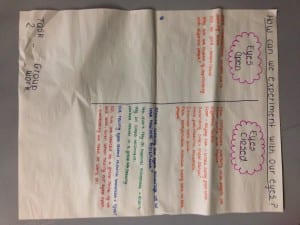This week we explored the rolling point and the interchangeable role of the under and over dancer.
After reading the journal Touch: Experience and knowledge, I gained an understanding that we are always in ‘touch’ with something when dancing, whether this be with a person, item of clothing, or the floor. I found this an interesting concept to work with. The way in which I personally interpreted this point, was that there will always be something there to support you, particularly looking at the idea of the floor supporting my weight. Investigating this concept further, we worked in partners and explored how we could safely give our weight to each other.
I was first to lie on the floor, whilst I had my partner slowly release her weight on to me. Before doing this task, I expected it to be quite painful, as I did not see myself as particularly strong, or able to hold someone else’s weight. Based on my previous experience of partner work, I was normally the person being lifted because of my build. Having this is mind, the task really surprised me and I noticed, as previously mentioned, that the floor acted as a support. Relaxing in to the floor, I was able to take the weight of my partner and the action of her rolling over me seemed almost like a massage, as opposed to being a painful experience.
When we then switched roles I was able to fully relax over my partner, taking care that i did not put any pressure on to her knees. I felt that this task encouraged us to put more trust in to eachother and to feel more comfortable. In affect, this then improved how we worked together for the rest of the lesson.
References:
Touch: Experience and knowledge. Full Text Available By: Bannon, Fiona; Holt, Duncan. Journal of Dance & Somatic Practises, 2012, Vol. 3 Issue 1/2 p215-227

